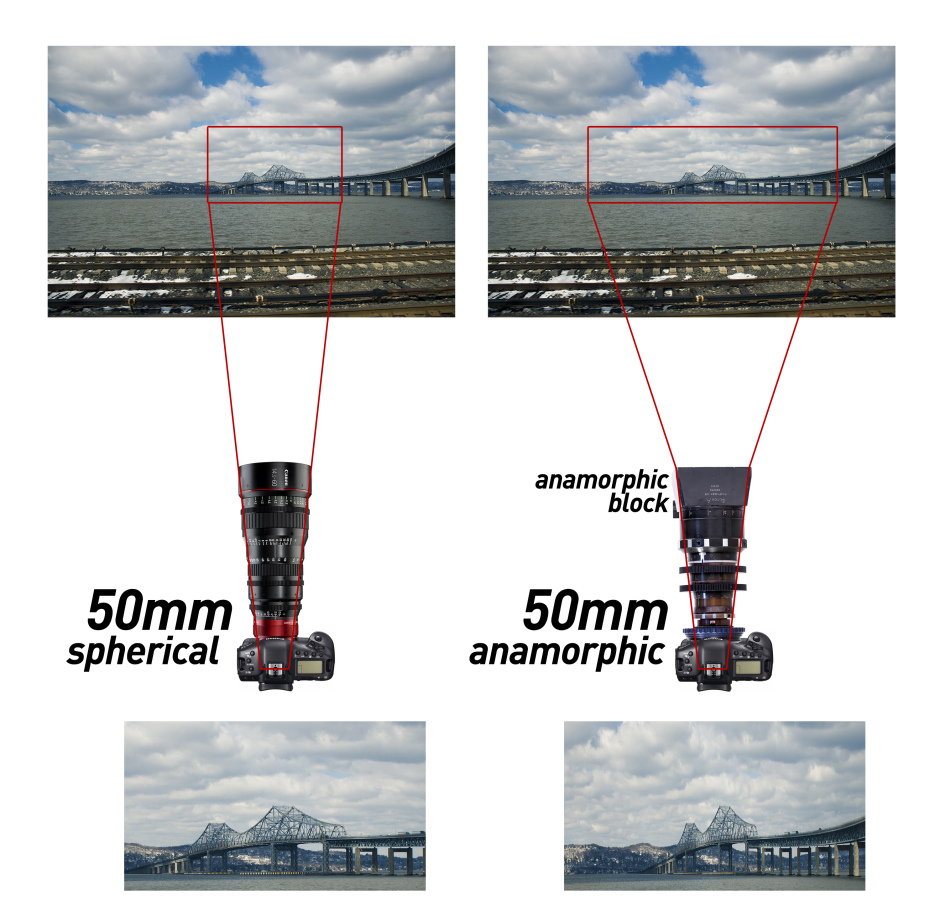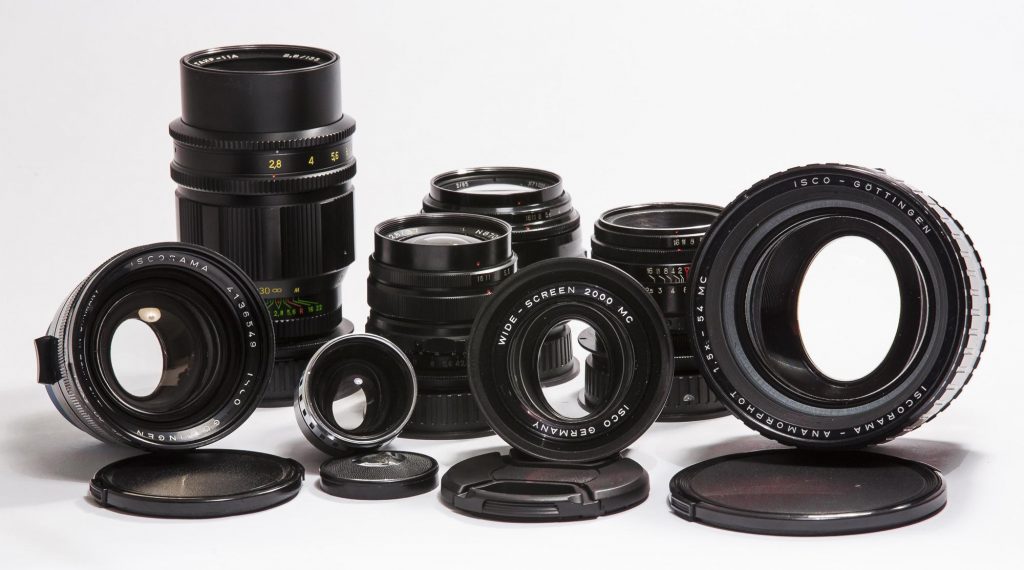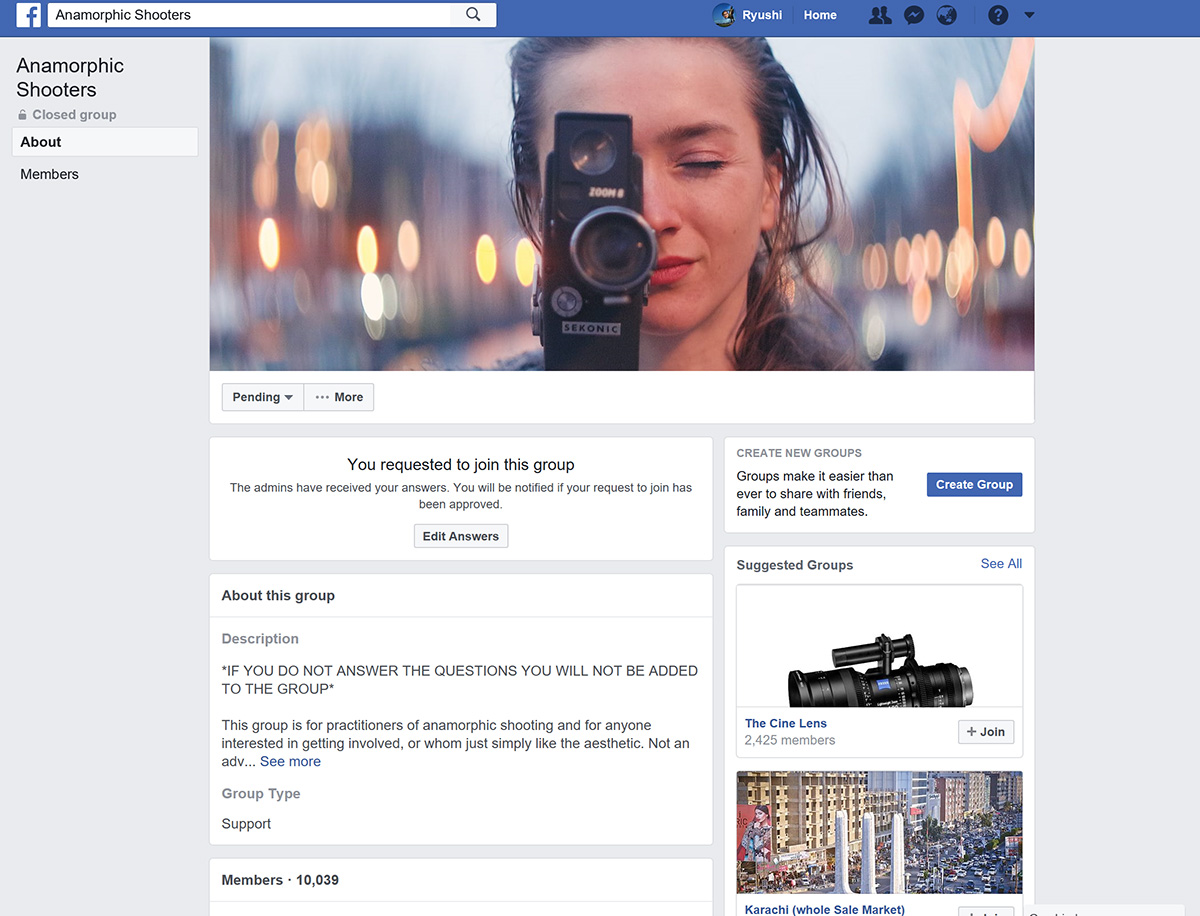
How to Shoot Anamorphic on a Budget: Interviewing Lens Expert and Filmmaker Tito Ferradans
Vintage lens fans and sufferers of gear acquisition syndrome will no doubt be familiar with Tito Ferradans from his YouTube channel and strong presence on Facebook. His channel branding gives him the appearance of a mad professor: his thumbnail shows him in white labcoat and glasses, and regular viewers will be familiar with his wild curly hair (for which he has actually received criticism online; something about not looking professional, although I challenge you to show me any filmmaker who dresses up). He could be a relative of Doc Brown, or Robin Williams’ Professor Brainard from Flubber, except his area of expertise is anamorphic lenses rather than time travel or green jelly creatures.

Originally hailing from Brazil and now based in Vancouver, Ferradans has been investigating budget anamorphic lenses for several years. He is currently in Tokyo on a top-secret project “to do with anamorphic”, so I take the opportunity to meet him at a coffee shop in a Tokyo suburb, to discuss his work. It is 10:30 in the morning, and the outside temperature is already over 20 degrees celsius, so he shows up in a T-shirt that reads, “I See the World in Cinemascope,” underlining his passion for anamorphic. From the first question I ask him, he is animated, confident, passionate, giving the long, detailed answers every interviewer dreams of.
I ask him to explain anamorphic as if I were a complete novice to the subject. “The word anamorphosis means to change, to distort an image, in a specific way. And for photography, or cinematography, you’re distorting that image on the horizontal axis. So you’re putting glass in front of your lens that makes it see wider horizontally. It sees more than your lens does, and it squishes it onto the center.” Essentially, anamorphic lenses allow one to squeeze a wider (2.39:1) image onto a 4:3 sensor or celluloid frame: an image which must then be de-squeezed in projection.

Unprompted, he traces the history of anamorphic for me, from Hollywood’s appropriation of military technology to capture more spectacular images than television (anamorphic lenses were invented by a French astronomer/scientist to allow tank crews a wider field of vision), to the current boom which he credits to the HDSLR revolution. “When the Canon 5D Mark II was released in 2008, suddenly it became very cheap to get shallow depth of fields and everyone was making beautiful images, but wanted to make them look more like cinema. They were like, ‘How do we make this normal-looking image into something cinematic?’ Anamorphic is going to give you a bunch of things that big budget Hollywood films have, if you’re patient enough for a fraction of the price that Hollywood pays.” This is Ferradans’ real area of expertise: anamorphic lenses on a budget. So much so that he wrote a 100-page primer on the subject as part of his final undergraduate project, a text which he has since translated into English. However he may be best known for his YouTube channel, where he has over one hundred videos on anamorphic lenses.

I ask what initially drew him to anamorphic and sparked this early research project.
“I had a Canon 7D and a bunch of Canon glass. And then everywhere I went to shoot, everybody had the same gear, and all the projects had the exact same look. I was bored of it and looking for something interesting, so I went into anamorphic. It made zero sense in the beginning.
“I bought four lenses. They were so cheap back then, it was great – I only spent two thousand dollars. Today, two grand gets you one lens, maybe. They were all very different from each other so I started to figure out how to mount them, and how things worked.
“I got a couple of working setups, which were different from each other. One was German, and it was based around a Zeiss lens as the base. And then an Iscorama adaptor in front. That setup was super sharp at any aperture, which is not the case for all anamorphic. I also had a huge Lomo cinema lens that I was able to get while my sister was in Europe. When I got that I wanted to compare both options. The full lens versus adaptors, and shooting full frame versus shooting with Super 35.”

This comparison became a combination of practical filmmaking and empirical research, examining the differences between the legitimate Lomo anamorphic cinema lens and a Zeiss/Iscorama adapter. Once done with his degree, he published his findings on his personal blog.
“Views on the blog were about thirty or forty every day. Then I translated all of it, the full hundred pages, from Portuguese to English on a twelve-hour flight from Canada to Brazil. Boom. Two hundred, 250 views, every day. But after translating it, people were still coming up with questions as there’s no organised source of information about anamorphic lenses anywhere and it’s a nightmare to get started. So I decided to start making videos talking about specific lenses in 2015: shooting tests and showing what’s good and what’s bad about each lens.”
Ferradans is still the only person tackling budget anamorphic shooting in detail, despite a growing community. The Anamorphic Shooters Facebook group, which he recommends as a resource, now boasts over ten thousand members and his own profile has grown too. “The coolest thing happened at the end of last year and the beginning of this year. people started to offer to ship me their own lenses, for free to review and then ship back.There have been more than ten lenses now that people shipped out to me. It’s such a level of trust on someone on the internet that I’m like, ‘What? I don’t understand.’ But, I’m very honored. It means a lot that people trust me like that.”

I ask whether he has experienced any pushback from established anamorphic shooters for growing the community and driving up prices through increased demand.
“There are two sides to that argument. One side is, before [this growth] there was no information, so if you found out a really cool secret, you would keep that for yourself, and you would benefit from it alone. When you start sharing things and your findings and whatnot, you drive up demand, which is why the prices are going so high. In a year they more than doubled, I think, for most adapters. But it’s a very small group of people who say I’m giving out all the secrets. And they come back saying, ‘That was a really cool video, and you should try out this and that.’ It turns out they like my content.
“I think overall, people are happy that there’s more information going around. It’s more of an exchange. You show the things you’ve learned, and then somebody else shows the things they have learned. It strengthens the group, and as a community, we kind figure out what’s great and what’s not so great.”
Nevertheless, Ferradans suggests caution to people considering diving into the anamorphic world. “It’s going to take all your money. And it’s very, very addictive. Your setup is always nearly perfect but you never quite get there. There’s always, ‘I need a new adapter, I need a new diopter, I need a new taking lens, I need a new thing that’s going to come out next year…’ It’s very hard to build a good setup as it’s a lot of small pieces put together. There are too many variables. There are unlimited options.
“So if you want to start out in anamorphic, be patient and research. Always read up on what you’re considering buying. If you find an adaptor, see what everybody has posted about it, and if there are test videos. Ask questions. If you want to spend five bucks, you can do it. If you want to spend five thousand bucks, you can do it. And everything in between. SLR Magic have been working really hard to make cheap anamorphic lenses that are an easy way to start.”
One of Ferradans’ reviews of an SLR Magic adaptor.
Does he prefer modern solutions like the SLR Magic lenses, or vintage combinations like the ones he started out with?
“That’s a trick question. It depends on the project. But, for starting out, I would say SLR Magic is one of the best ways to go. It’s simple, it’s cheap. It’s going to give you the feel for anamorphic. I’ve had all of their adapters so far and I liked most of them.
“This is the sad part which will come up on the channel soon though – I got tired of adapters. It’s too many parts to make something work for fifty different options, and you’re compromising on all of them. So, I think I’ve reached my threshold for dealing with the limitations of adaptors. I still think they’re the best way to start: if you’re not doing this for living, adaptors are the best thing to do.
“Last year, though, I came across a set of Lomos, which are Russian cinema lenses, in Brazil. A friend of mine had them. They were all messed up but I made him an offer, and he was like, ‘Yeah, sure.’
“So, I bought the lenses. I had to spend another six months hunting for parts. I went after the people who could fix them, and they all turned me down, saying it was too much trouble and would cost more to refurbish than the lenses were worth. But then, at the end of the year I found Van Diemen in the UK. They rehouse various lenses, and they’ve started doing Lomos. They’re with them right now and they’re going to come back sometime in the next month, hopefully. When those arrive I’m going to get rid of a bunch of adaptors.”
“I also had a huge Lomo cinema lens that I was able to get while my sister was in Europe.”
Tokyo is a mecca for stills photography gearheads, with rarer vintage cameras and lenses often appearing on the market in tip-top condition. However, it can often be more difficult to find cinema equipment made before this century, irrespective of condition or pricepoint. I ask Ferradans whether he has had time to have a root through the abundant used camera shops of Tokyo.
“Yeah, I went looking for stuff twice. The first time, we went to Nakano and everywhere was just empty; we didn’t find anything. There were no used lenses: nothing. Both times I went with friends that live here. They’re really into anamorphic and they never find anything. The second time, just for fun, I went to more camera shops in a two-hour timespan in Ginza than there are camera shops in Vancouver.
“The first store we went to on that second day, on the shelf there was something anamorphic and French and cheap. So my friend bought it, and we tested it out. It works really well. It’s sharp, so it’s in good condition, and he got a good deal on it. So, from there we went to a bunch of other shops. It was mostly Nikon, Leica, etcetera. So then we went to a junk shop to look through the random lenses they had. We were trying to find cheap enough lenses that we could experiment with, and the shopkeeper brought out a box of free ‘junk’, where I found the filter from the video I posted last weekend. It was in the free box. It’s something I’d never seen before but on eBay it’s going for 30 bucks. It’s very, very tiny, and cheap and low quality, but it’s a fancy way of faking it, and nobody quite knew what it was. Going around Tokyo and looking for anamorphic has been interesting. I think there are lenses to be found, just not in the obvious areas. I was expecting to find none, and I found some, which is a very positive thing.”
“The shopkeeper brought out a box of free ‘junk’, where I found the filter from the video I posted last weekend”
Ferradans is not just a lens guru, though. He booked a range of camera and lighting department jobs between graduating and going full time as a lens expert, and he also works on his own creative projects. Last year, he directed the short film Up & Away, which is currently doing the rounds on the festival circuit. A “sci-fi, dystopian story with strong visuals, about a couple in a society at the brink of collapse [who] have a chance to start over aboard a colony spaceship”, it was shot on “six or seven completely different locations” over three days with no sleep. “I don’t know how I made it through”, he laughs.
Ferradans stresses the importance of having had a gender balanced crew. “The writer was female; the producer, the lead actor, and the production designer were female; the effects supervisor was also a woman. We were pretty much 50/50, which was a really good experience and added different perspectives to the production.” His director of photography was female too: “My DoP and I worked together a bunch. I DPed the films that she directed, and she DPed both of the films that I directed. The camera and the lighting crew were really, really into it. I worked with them when I was DPing, so they all knew my style. I could trust them, which was amazing.”
The trailer for Up & Away
He currently has two narrative projects he is developing. “One is a noir VR experience in which you have the option of following the character’s story, or making your own conclusions, and by the end, both paths will lead to different conclusions. If you follow the story, you will believe in one thing, but if you do your own looking around, you’re going to find out another thing about the crime.
“The other project is about a group of friends caught up in a diner in the middle of nowhere, and they get a missile alert, like what happened in Hawaii, and here in Japan as well with North Korea testing ballistic missiles. This is about how they cope with the last ten minutes of their lives.”
He also likens his most-viewed video of the year so far, an April Fools prank announcing a fictional lens, Scope, to a narrative short. “It worked out really well. Most videos do a thousand views on the launch day and a thousand views over the first week. This video did ten thousand views in two days. The next week, when I revealed it was not true and it was just an April Fools, some people were like, ‘Wow. That was really cool.’ And some people were like, ‘I dunno man. You seemed so reliable.'”
He wanted the video to be a cautionary tale for lens fanatics. “The reason I made the video is because there is always someone who announces they’re making a new lens. And I’m like, ‘I’ve never heard of you, you have no history making lenses, and you’re going to open a Kickstarter campaign asking people for $1,000, and they’re going to give it to you? I don’t know if that’s a good idea.’ So, I wanted people to be more careful with getting information and figuring out what is it that manufacturers are doing.”
Ferradans’ prank video hit ten thousand views within the first two days of its publishing.
Whilst the Scope video hit ten thousand views in two days, some of his output only reaches a few hundred. Nevertheless, between YouTube advertisements and Patreon support, Ferradans makes enough money to be a lens guru full time. He says he initially had very little income from Patreon, until he began to focus on giving his backers value for money. “I changed approach, to give better tips and early access to the videos to the people on there. For the past few months I’ve had one week early access for everybody on Patreon. That income helps a lot with allowing me to focus on the project, and in exchange I can answer people’s questions. I get more than one hundred, two hundred people asking questions per week on Facebook, email, YouTube, Vimeo, and Instagram. So, if I wasn’t making this a job, I wouldn’t have time for it all.”
He is confident that his audience, which he has refined over the years, will continue to watch his content, and a lot of his growth is organic: “People show up and go, ‘I just found out about your channel, and I spent the last three days watching everything.’ I don’t know where the videos really go. I publish them, and then I share them on the Facebook group. I used to share them everywhere, but I would get like three likes, four likes, and no one would say anything in the filmmaker groups or my personal profile, so I decided to stop putting so much effort into that and to focus on the people who are interested.”
Does he tailor his content to what audiences are requesting? “I’ve done a lot of things to follow what the audience wants, where they want to see a review of this, a review of that, a test of these adaptors, or pitting these three things against each other. I’m always trying to follow what people are interested in, but at the same time I’m trying to catch up on forty years’ worth of adaptors that have no information on them. Everything I put out about products that are on the market does well, so I’ve reached out to companies and companies have reached out to me, to test gear. I’ve tested things that I really liked and I’ve tested things that I really didn’t like. One of the SLR Magic adapters I tried out didn’t go well, and they understood; they didn’t hate me. They still sent me gear later to see if the issue was fixed, and it was much better. So it’s about putting these two universes together. People want to see good anamorphic products. That is a fact.”
Where to Find Out More About Anamorphic
Check out Tito Ferradans’ YouTube channel.
You can also follow his work on his blog and his Instagram.
Want to ask him a question? Show him some love and support first on Patreon.

One thought on “How to Shoot Anamorphic on a Budget: Interviewing Lens Expert and Filmmaker Tito Ferradans”